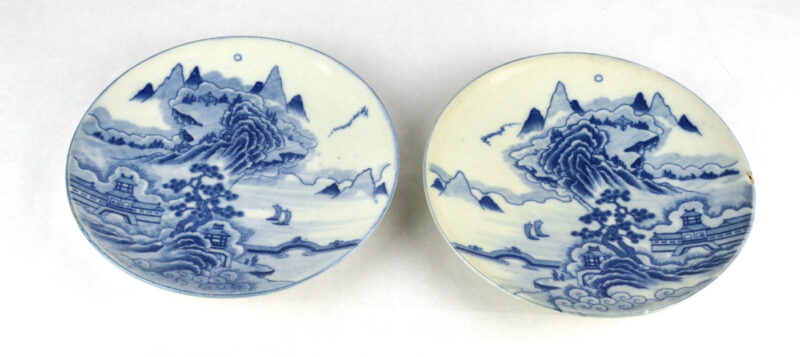Hairline – Hairline cracks usually show up as dark gray lines on the surface of a piece. These cracks go through to the inside where they also show up as dark lines. They are most often found near an edge. Sometimes called stress cracks or age cracks, they have a negative effect on value. They are often difficult to detect on pieces with dark glazes.

Crazing – Crazing is the appearance of cracks in the glaze. These cracks DO NOT go into the clay body of the piece. Most often they are the result of thermal stress caused by the fact that the clay under body has a different rate of thermal expansion than the glaze surface. Crazing is NOT an indication of great age. Some pieces have been intentionally
crazed. Crazing may have negative effect on value. Crazing is caused by glaze being under excessive tension.


Chip – A chip is a missing portion of the item, or a portion glued back into place (repaired chip). The missing portion includes some of the clay under body. Has a negative effect on value.
Nicks – A SMALL impacted area where a very small portion of the glaze is missing. These areas often go undetected, and do not expose the clay under body. May have negative effect on value.
Ding – see Nicks
Flake – Caused when a portion of glaze is lost from the piece. Often in conjunction with crazing. Has a negative effect on value. Flaking is caused by glaze being under excessive compression.
Flux – a chemical added to ground silica glaze to lower its melting point.
Factory Flaw – In general, factory flaws are imperfections introduced during production. Examples include bubble bursts in the glaze, glazed over chips, “kiln kisses”, and the like. “Old chips” cannot be considered factory flaws unless there is some portion of it glazed over. Hair line cracks, crazing, dings and nicks and flakes are not factory flaws even though they may have occurred at the factory. The rule of thumb is: If you can’t reasonably prove it happened at the factory, it didn’t, and should be graded accordingly.

Kiln Kiss – Occurs when two pieces are fire in contact with each other. The resulting flaw often appears as a burn mark, and or large glaze bubble burst.
Kiln – A kiln is a device, an oven, where pottery and ceramics are baked (fired) at very high temperatures. Early Chinese kilns were build on hill sides to create powerful air drafts on the intake side and allowing the kiln to consume huge amounts of oxygen and reach the temperatures needed to fire porcelain (see Dragon Kiln).
Glaze – Ground glass, flint or other ground silica material applied to the surface of a clay object and then fired at high temperature to fuse it to the object. Early glazing sometimes was accomplished by applying a flux to the raw clay and firing. This turned a thin layer of the clay to a glaze. A common flux was salt creating what we call salt glazed pottery.
Slip – A slurry of clay used to cast objects in a mold. Slip is poured into a mold and and allowed to set up on the outside (slip cast). The still liquid center is poured off leaving a hollow clay object. Colored slip is often used like paint to decorate clay objects.
Glaze Miss – A small spot on an item where the glaze did not cover. This is a factory flaw and treated differently for different potteries when it comes to value. For potteries with high quality control (like Rookwood) these may reduce vale as they would be a factory “second”
Rub – A small area where the glaze has been worn thin through use. May also describe an area of several small scratches.
Cone – A measurement of firing temperature. Higher cone numbers indicate higher temperatures.
Matte – Indicates a low shine finish
High Gloss – Indicates a high shine finish
Thrown – Process of making a piece with the use of a potter’s wheel.
Slab Built – Process of building a piece without the use of a wheel.

